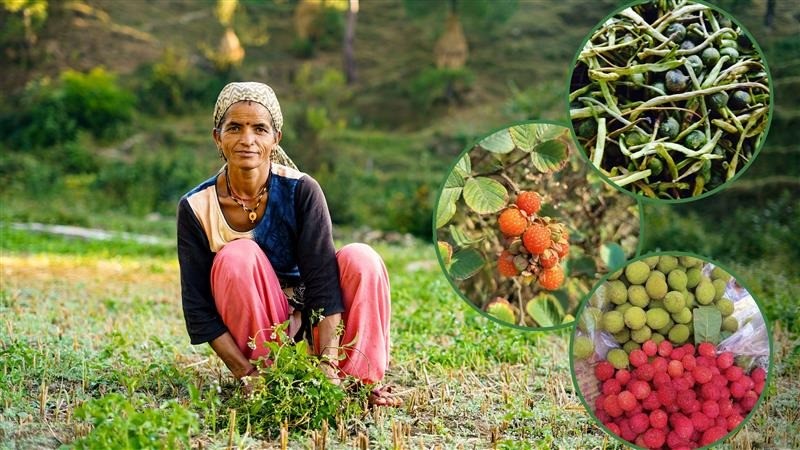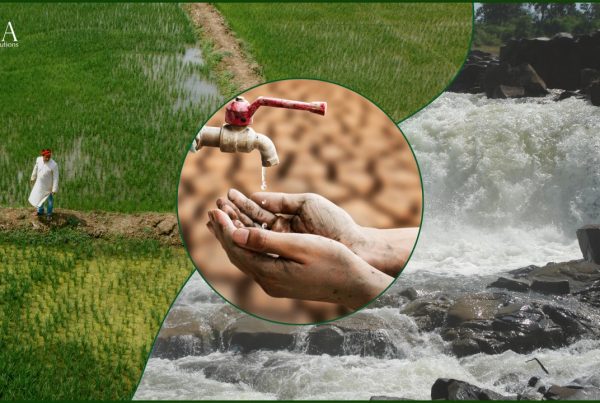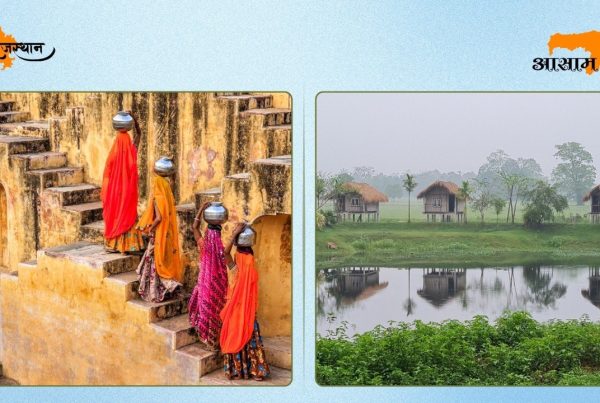For centuries, forests have been more than just towering trees and dense canopies – they have been silent providers of food, medicine, and sustenance for countless communities across the world. Nestled within forests are foods once staples in our diets, but now slowly fading from our plates. These “forgotten foods” – rich in nutrients and deeply rooted in cultural traditions – once formed the backbone of local food systems. They nourished generations, adapted effortlessly to local environments, and thrived without chemical intervention.
However, the rise of modern agriculture and industrial food systems side-lined these once-cherished staples. The Green Revolution’s emphasis on high-yield crops and government policies favouring calorie-dense staples over nutritional diversity – the need of the hour then, – along with changing consumption patterns has led to the gradual disappearance of indigenous foods. Once a diverse food landscape, enriched by locally adapted crops and wild edibles, India has now adopted a homogenized system dictated by market forces. Traditional foods, once celebrated, often dismissed as “poor man’s food” and abandoned in favour of commercially viable alternatives. The consequences of this shift have been particularly evident in nutrition profiles of forest-dependent and agrarian communities.
But forests still hold the key to a more resilient and diverse food future — if only we choose to listen.
Roots of Resilience: Learning from Indigenous Communities and their Food Traditions
The Baiga tribe, indigenous to the forests of Madhya Pradesh, has long relied on wild edibles like kodo millet, kutki, tubers, mahua flowers etc. – nutrient-rich foods that thrived naturally. These traditional staples required minimal agricultural intervention, ensuring a sustainable and self-sufficient food system. However, deforestation, commercial farming, and restrictive land-use policies have dramatically altered the Baiga way of life. A study in Baiga Chak[i] revealed a sharp two-decade decline in the availability of traditional food sources. Where families once gathered wild greens, honey, and roots freely, they now rely heavily on government rations of wheat and rice under the Public Distribution System (PDS). While these subsidized grains address immediate hunger, they fall short on the nutritional diversity, leading to rising malnutrition, loss of food sovereignty and erosion of cultural food heritage.
Similarly, in the arid landscapes of Rajasthan, traditional staples like pearl millet (bajra), moth beans, and wild berries have historically sustained communities against extreme heat and water scarcity. However, changing agricultural policies and shifting food habits have led to their decline. Ker-sangri, a dish made from wild beans and berries, once a survival food for desert communities, has now been pushed aside as small farmers pivot toward cash crops like mustard and cotton, which promise higher economic returns but require intensive water and chemical inputs.
In Meghalaya, the Khasi, Garo, and Jaintia tribes have long foraged forest-sourced fruits and vegetables, forming a diet deeply connected to the region’s biodiversity. However, much like in other regions, these traditional foods are gradually disappearing from major city markets, making them less accessible to urban populations. Despite this, rural communities here do continue to hold onto these traditional foods. Home gardens and weekly markets in the Khasi-Jaintia region still brim with these seasonal treasures: Soh-shang (Silverberry) and wild berries in spring, Soh-phie (Bay-berry) and Soh-myndong (Burmese grapes) in the summers, and wild peaches, plums, and pears during the monsoons and post-monsoon, So-hiong (blackberry), Soh-phoh (wild apple), and Sohot (chestnut) flood the local markets. Unlike widely cultivated horticultural varieties, these are naturally growing forestry species, thriving in the region’s diverse landscapes. Similarly, in Garo Hills, several varieties of wild lemons and oranges continue to thrive, and among them Memang Narang – the Indian wild orange (Citrus indica), – considered a primitive ancestor of all cultivated citrus species, still grows on these hills. Yet as farmers shift to hybrid varieties for better commercial returns, indigenous citrus species are becoming scarce here as well, their value diminishing over time.[ii]
It is not just fruit disappearing from our plates. Wild leafy vegetables like Jamyrdoh (Fish mint), valued for its blood-purifying properties and ability to strengthen immunity, and Jarain (Buckwheat), packed with vitamins, though staples in many kitchens in Meghalaya, are losing importance among the younger generation. Similarly, forest-sourced wild mushrooms cherished as a seasonal delicacy, and traditional red sticky rice and black rice that hold cultural significance, are losing out to modern diets that increasingly favor commercially available alternatives.
But this isn’t just a story of loss. The persistence of these foods in village homes and markets in many parts of India speaks to the resilience of indigenous traditions. Their revival isn’t merely about cultural or nostalgic movement – it is a strategic response to some of the urgent, interconnected challenges: climate change, malnutrition, economic instability, and food insecurity.
Rediscovering Indigenous Foods amidst Climate Crisis
As rising temperatures, erratic rainfall, and soil degradation threaten conventional agriculture, these traditional foods offer a sustainable alternative. Indigenous grains like millets, pulses, forest tubers, and wild greens are naturally climate-resilient, require minimal water, thrive in poor soils, and can withstand extreme weather conditions. Unlike commercial cash crops that rely heavily on chemical inputs and monoculture farming, these traditional foods also integrate seamlessly into sustainable agricultural practices. They are also nutritional powerhouses – naturally rich in vitamins, minerals, and fibre – providing a natural antidote to India’s dual burden of malnutrition and lifestyle diseases like diabetes and hypertension.
With India’s population projected to exceed 1.6 billion by 2030 and food demand expected to hit 400 million tonnes (MT) by 2050 (as estimated by the Indian Agricultural Research Institute (IARI)[iii]), reviving forgotten foods is no longer optional. Relying solely on high-input, water-intensive crops like wheat and rice will continue to degrade soil, deplete groundwater, and worsen biodiversity loss. The solution lies in diversifying food production by reviving forgotten foods, which are inherently resilient, require fewer resources, and can be cultivated in degraded or climate-stressed regions.
Driving Change through Policy Support
India’s policy initiatives align with efforts to revive forgotten foods, promoting self-reliance and regional food systems. Initiatives like Atmanirbhar Bharat and Vocal for Local provide a platform to brand and market indigenous foods, fostering regional food economies. The One District One Product (ODOP) initiative promotes region-specific crops like kodo millet in Madhya Pradesh and black rice in Manipur, giving rural famers a competitive edge.
India’s commitment to climate action, outlined in our Nationally Determined Contributions (NDCs) and the Lifestyle for Environment (LIFE) framework, also support low carbon, sustainable agriculture, both of which are inherently supported by the cultivation of indigenous, low-input crops. This is reinforced by the National Food Security Mission (NFSM) and the Millet Mission (Shree Anna Initiative), which promote integrating climate resilient staples like millets into mainstream diets.
Forest-based foods also gain recognition under Pradhan Mantri Van Dhan Yojana (PMVDY), empowering tribal communities to process and market forest produce. Policies like Paramparagat Krishi Vikas Yojana (PKVY) promote organic farming, while the National Agroforestry Policy and Rashtriya Krishi Vikas Yojana (RKVY) support climate-resilient crops. Meanwhile the Eat Right India campaign drives awareness of indigenous foods’ nutritional benefits, fostering healthier, more diverse diets. By integrating these initiatives, India can build a self-sufficient, nutritionally diverse, and ecologically sustainable food future by rediscovering and revitalizing the foods that once sustained us – without needing to reinvent agriculture
MegCare: Reviving Traditional Foods through Agroforestry
In Meghalaya, IORA’s MegCare (Meghalaya Carbon Agroforestry for Community Resilience and Ecosystems) initiative is helping farmers bring back traditional foods – not just to preserve heritage, but to create a more resilient future. The focus is on restoring native fruit tree species and traditional crops through agroforestry models tailored to the region’s diverse landscapes. The initiative will go further by developing value chains for indigenous produce, helping farmers process, package, and sell their harvests at better prices.
Another key component of MegCare is its carbon incentive model. Farmers are not just supported with plantations, they are also rewarded for carbon sequestration through agroforestry, helping them earn additional income while contributing to global climate action. MegCare is not just reviving forgotten foods – it is also strengthening food security, restoring ecosystems, creating economic opportunities, and ensuring Meghalaya’s rich food heritage thrives for future generations.
As we celebrate International Day of Forests, let’s recognize forests not just as carbon sinks or biodiversity reserves, but as vibrant food repositories – capable of combating climate change, restoring lost culinary traditions, and ensuring food security for generations to come. The path forward lies in rediscovering, reviving, and reimagining our forests and the forgotten foods they still hold.






